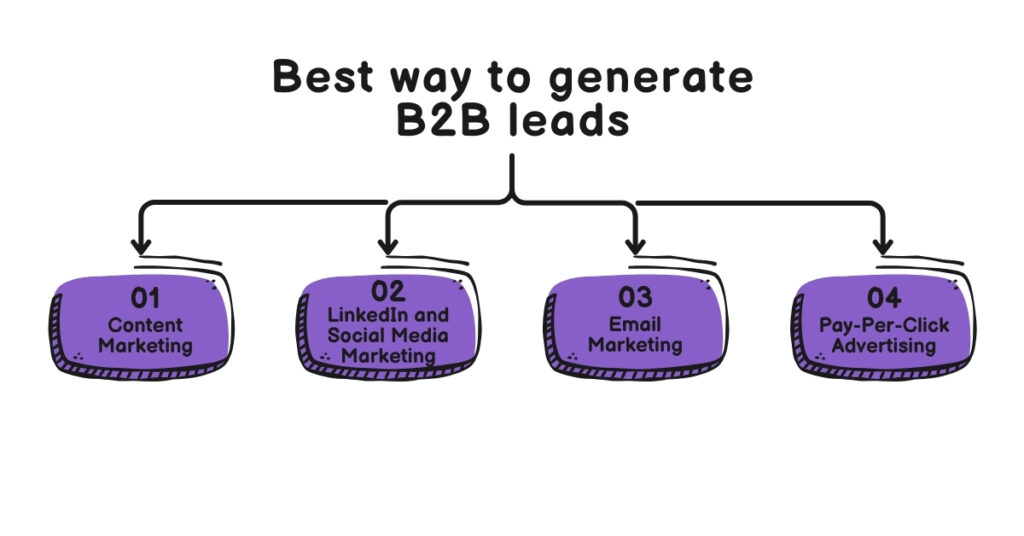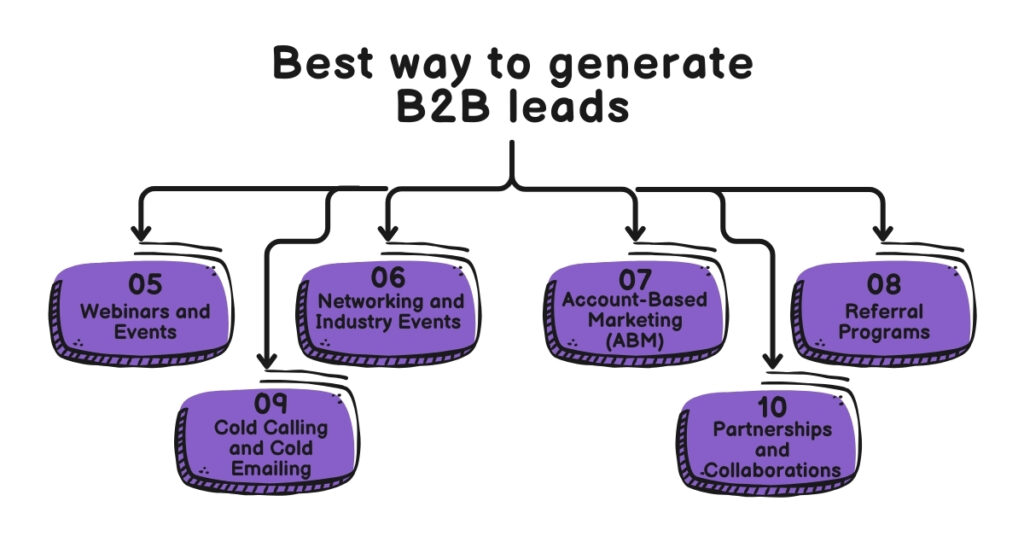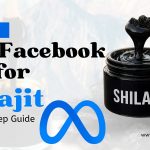What is B2B Lead Generation?
In B2B Lead Generation, the Term B2B abbreviates business-to-business, meaning that one company is selling to another, not to some consumer in B2C—business-to-consumer.
Finding new customers is perhaps one of the most important jobs of any business in today’s competitive environment. However, the process is much different for companies that sell their products or services to other businesses. Selling a product or service to another business is called B2B lead generation.
Furthermore, Lead generation in B2B forms includes finding potential customers who are termed “leads.” They may be persons interested in a business or organization’s offers. So, The goal is to find leads and execute the process that finds them, deals with them, gets connected, builds relationships, and ultimately goes on with their conversion into payers.
In this article, we’ll discuss the basics of B2B lead generation, its importance, steps, and best practices for generating leads for your business.
Why is B2B Lead Generation Important?
Lead generation is the lifeblood of new business opportunities since no business will expand its customer base without it. The following are a few reasons why B2B lead generation is critical:
- Expansion of Business Reach– Continuously generating leads will help businesses find new customers and expand into new markets.
- Relationship Building-B2B sales depend primarily on relationship building, establishing a baseline level of trust. Lead generation means you can start to build a relationship much earlier.
- Revenue Development-Revenue will eventually level off if there’s not a steady flow of fresh leads. Lead generation powers your sales pipeline by providing potential customers to drive future revenue.
- Competing Companies that get qualified leads consistently will easily outcompete their competitors and win clients within their desired market.
Read More: Social Media Advertising -An Overview
How Is B2B Lead Generation Processed?
B2B lead generation is a multi-step process. So, These multiple steps ensure you get leads that are right for your business and will buy:
Know Whom You Are After
The first step is to identify who your ideal customer is. Specifically, Not every business will be a good fit for your product or service. To generate effective leads, you have to identify:
- What industry do they belong to
- The size of the company-whether it is a small, medium-sized, or large company
- Their specific needs or pain points
- Who makes the buying decision in an organization?
This is often referred to as defining your buyer persona. Hence, it is helpful to get a good sense of what kinds of companies are most likely to become customers.
Find Potential Leads
Once you’ve established your target audience, the next step is identifying potential leads. Here are a few strategies you can use:
- Online research
You can do this by using LinkedIn, business directories, or industry reports to obtain businesses that fit your target profile.
- Networking
You attend conferences, trade shows, or industry events, where you are likely to meet new potential customers.
- Inbound Marketing
Create content to pull companies in, such as blog posts, whitepapers, and eBooks. That way, instead of going out and looking for leads, you have leads coming to you.
Capture Leads
You’ve got leads now. You want to capture their contact information. You can capture leads by offering them something of value in return for giving you their contact information, such as:
- Free resources, such as whitepapers, eBooks, or guide
- Webinars or demos
- Free trials or consultations
Moreover, Having a perfectly designed landing page or lead capture form on your website can help gather this information pretty efficiently.
Qualify Leads
Not all leads are ready to buy. Lead qualification is the process of determining how likely a lead will become a customer. How is it done? In other words, what can be gathered from the lead?
- Does the company need your product or service?
- Is there enough budget for it?
- Are they ready to spend money in a reasonable period?
You can qualify leads through lead scoring or simply by asking qualifying questions in your initial interactions. Qualified leads are prioritized because they are more likely to convert into paying customers.
Nurture Leads
Lead nurturing is the process of building relationships with your leads over time. This is especially important for leads that are not ready to buy right now. You can nurture leads by:
- Sending regular newsletters through email with helpful content
- Education about your product or service
- Engagement with the person on social media or personal emails
Lead nurturing ensures that when a lead is ready to make a purchase, they will remember your business.
Convert Leads into Customers
All leads have to be converted into customers. When the lead is ready to buy, your sales team can start negotiation, product demo, proposal sending, and closing the deal. A good sales process is smooth and efficient to achieve a higher conversion rate.
In B2B Lead Generation, What are B2B Leads?
B2B leads refer to potential business clients who are interested in a company’s product or service. In B2B or business-to-business, firms sell their offerings to other businesses rather than individual consumers (as in B2C or business-to-consumer).
A B2B lead is any business that meets your target audience and thus has the potential to be a client. Every business that aims to increase its client base, sell more, and enter new markets needs these leads.
Types of B2B Leads
There exists generally two categorizations of B2B leads based on interest and purchase intention;
MQLs
Marketing Qualified Leads are companies that have shown a desire for your offering but don’t intend to buy. For example, an MQL would be a company that downloaded your whitepaper, registered for your free webinar, or subscribed to your newsletter.
SQLs
These are more advanced leads who may be closer to buying a product and can buy it more immediately. Hence, they could have requested a product demo or contacted the sales team for more precise information.
What is the best way to generate B2B leads?
It may depend on your industry, target audience, and business goals. Still, the following are the most effective ways to generate B2B leads: Proven strategies work well across various sectors. Below are some of the most effective methods for generating B2B leads:

1. Content Marketing
Why it works?
The best quality content positions your business as an authority in your area. By providing useful, informative content, you attract businesses that are searching for solutions to their problems.
How to do it?
- Blog posts, whitepapers, case studies, and infographics that are designed to answer frequently occurring pain points in your industry.
- Use SEO to optimize your content to make lead capture easier for the searchers.
- Insert lead capture forms or CTA buttons that encourage people to download a freebie or demo in exchange for contacting you.
2. LinkedIn and Social Media Marketing
Because LinkedIn is directed to professionals, it’s also one of the best platforms for B2B marketing. However, with that said, you can still reach business decision-makers with Twitter or even Facebook.
- How to Share content and insights that create relevance with your target audience.
- Engage within LinkedIn Groups of your industry interest
- Use Sales Navigator on LinkedIn to find leads based on job titles, business size, or industry.
- Direct message prospects with personalized outreach.
3. Email Marketing
Why it works?
This channel can target potential leads with personalized, relevant content, which is a very effective way to nurture relationships over time.
How to do it?
- Build email campaigns that target prospective buyer needs or interests.
- Segment out different types of messages to send at different stages in the buying process.
- Publish high-quality, lead-magnet, or freemium content, Also Send follow-up messages to potential leads through automated emails and emails
Also, visit: Digital Marketing Services
4. Pay-Per-Click Advertising
Why it works?
PPC campaigns, such as LinkedIn Ads or Google Ads, let you target businesses that are actively seeking products or services similar to yours.
How to do it?
- Targeted ads based on your ideal customer profile.
- Use relevant keywords related to your business so that your ads will be shown to leads at the right time.
- Run and refine your ads for maximum ROI by tracking which campaigns generate the most leads.
Read more: Pay-Per-Click Advertising

5. Webinars and Events
Why it works?
A webinar and a live event are the best ways to reach leads in real-time while speaking to their pain points.
How to do it?
- Host educational webinars that provide valuable insights, solutions, or industry trends
- Promote your webinars through email marketing and social media to attract relevant leads.
- Include a Q&A session as part of the event to answer customer queries directly Capture attendee information for follow-up.
6. Networking and Industry Events
Why it works?
Certainly, In-person networking and industry events are worth capitalizing on to build relationships with decision-makers and generate leads within an industry.
How to do it?
- Attend trade shows, conferences, or industry events where a prospect might like to be.
- Host your events or partner with other businesses for co-branded networking opportunities.
- Follow up on the business cards or contacts gathered at the event to start building relationships.
7. Account-Based Marketing (ABM)
Why it works?
ABM is a very targeted approach, focusing on account-specific leads and setting apart a broad audience. This is mainly because it works well with companies seeking their most-valued clients.
How to do it?
- Identify a list of target key accounts that would make great clients
- Customize your marketing efforts (emails, ads, content) for each account’s specific needs and challenges.
- Use these leads by sending personal outreach, like one-on-one emails or tailored proposals.
8. Referral Programs
Why it works?
Word-of-mouth or referrals from contented customers are one of the most trusted sources of leads.
How to do it?
- Ask your current customers to refer your business to other businesses.
- Offer incentives in terms of discounts, credits, etc., on successful referrals.
- Maintain excellent relations with your current customers to make them willing to refer you.
9. Cold Calling and Cold Emailing
Why it works: Though it is old-school, cold outreach can still be very effective, especially when it becomes customized and targeted.
How to do it?
- Research companies that fit your target ideal client profile.
- Write messages that resonate with their needs, and follow up regularly with potential
- prospects with interest; be a helpful salesperson by using scripts that are based upon value propositions rather than being pushier, and use the value you bring to the relationship
10. Partnerships and Collaborations
Why it works?
You both get the other company’s customer base and vice versa.
How to do it?
- Find another business that offers complementary products or services.
- Collaborate on joint marketing efforts, webinars, or content partnerships.
- Best Practices for B2B Lead Generation
- Whichever strategy you employ, there are a few best practices to bear in mind:
- Target the Right Audience: Focus on businesses that could fit your products or services well.
- Personalize All: Be it email, running advertising, or outreach, Also personalize your message to map the specific business needs and where the pain is applicable.
- Follow Up Consistently: Do not wait for leads to magically convert. Then, Follow up and nurture them as they go through the buying journey.
- Measure and Optimize: Track the effectiveness of your lead generation campaign and refocus your effort to concentrate on what works.
Conclusion About B2B Lead Generation
B2B lead generation is the critical process that businesses that want to grow need to find new clients. This not only includes targeting people who might eventually buy the services offered but also actual meaningful relationships that can be used to support leads on their way through a purchasing journey. Furthermore, Businesses can bring qualified leads that might be converted to long-term customers using content marketing, social media, and email campaigns.
So, the bottom line is that to deliver B2B lead generation successfully, one needs to comprehend the target market, present value to that market, and interact with that marketplace across the buying journey. If done properly, this can lead to business growth and revenue improvements, as well as the ability to sustain a competitive advantage.
FAQs About B2B Lead Generation
How Do Businesses Get Leads in B2B Lead Generation?
Companies acquire leads through content marketing, social media, email campaigns, paid ads (PPC), networking, and cold outreach, often with tools such as CRM software and automation to capture and nurture leads.
Is B2B Lead Generation Worth it?
Yes, lead generation is absolutely important for business growth. It identifies possible customers, increases sales opportunities, and builds long-term relationships with clients.
Is B2B Lead Generation Sales or Marketing?
Lead generation is generally part of marketing, but the sales and marketing teams have a very close relationship. While marketing attracts leads, sales nurtures and converts those leads into customers.
What do you understand by the term Qualified Lead?
A qualified lead is a potential customer who is considering your offering and meets the qualifying criteria, such as budget availability, need for your product, and decision-making authority, before potentially becoming a paying customer.
How Does One Earn a Qualified Lead In B2B Lead Generation?
Typically, businesses generate qualified leads through targeted marketing initiatives, lead scoring, and nurturing. In addition, They often use personalized outreach, content offers, and engagement tracking to determine readiness to buy.




